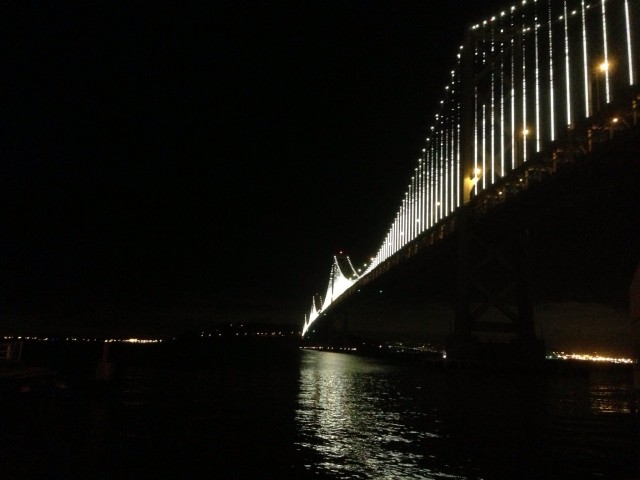The lack of public review was partly responsible for some major port development failures, the grand jury found, including the 8 Washington condo project, the America's Cup and the plan to use Piers 30-32 for a Golden State Warriors arena.
The grand jury characterized the port as a "land bank and real estate management company," and said that only 25 percent of its revenue comes from maritime activities. The annual revenue of $82 million isn't enough to cover all the infrastructure repair that's needed, the report said.
Although the report never mentioned George Lucas or the cultural museum he wants to build, it did talk about Piers 30-32 and Seawall Lot 330 — prime port property between the Bay Bridge and the Giants ballpark that Mayor Ed Lee has offered the filmmaker in an effort to keep him from giving up on the city and choosing Chicago instead as a venue for his $700 million project.
The Port should consider alternatives to fund the cost of rehabilitating Piers 30-32. The sale of Seawall Lot 330 could supply a large portion of $68 M needed to strengthen the substructure for light use. The Jury recommends that the Port actively investigate alternative light uses for Piers 30-32. In addition to general park usage, sports fields for soccer, tennis, basketball, or other sports could be provided. Temporary venues for entertainment companies such as Teatro ZinZanni, Cirque de Soleil, and Cavalia would also not require an extensive substructure. Although not light use, the Port might also consider placement of a major marine research institute to fully utilize the unique characteristics of this site.
After detailing the port's various triumphs and tribulations, the grand jury offered 11 findings and recommendations. Among them:
— Update the Waterfront Land Use Plan and put more emphasis on maritime use
— Restructure the Port Commission so that the San Francisco Board of Supervisors could make two of the five appointments, leaving the mayor with three -- instead of all of them, which is how things work now
— Require approval from the Port Commission and Board of Supervisors for all major events, such as the America's Cup, along with a validated cost proposal using fair market rental rates, revenue sharing with the port, marquee billing for the city and full accounting after the event
The 58-page report provides a close look at what the port does and how things work, and gives a sense of its vast scope. The port monitors about 550 port agreements with 394 tenants, ranging from a kayak-renting kiosk on a monthly lease to 66-year leases for cargo and ship repair facilities.
In spite of "operating in a very difficult environment of budget constraints, regulatory oversight and political influence," the report said, the port has chalked up many successes, including the renovated Ferry Building, AT&T Park and the relocated Exploratorium.
However, the grand jury report noted that cargo movement along the southern waterfront has declined drastically in the last 10 years, the Embarcadero suffers from severe congestion, and capital improvements at Piers 80 and 94-96 — to increase handling of containers —employed outmoded technology, to the point they are virtually unused today. And it lists what it describes as three notable failures:
America’s Cup
- Planning by the Port and the Mayor’s Office for the America’s Cup failed to include agreements that protected the City’s interests and failed to maximize the benefits that the City might have achieved. The usual agreement for sharing revenue from the proceeds of use of Port facilities was not included in the agreement.
- A new cruise ship terminal, built at considerable Port cost, was made available with no return to the City even though the America’s Cup sponsors promoted concerts and viewing suites that potentially resulted in large profits for the sponsors and nothing to the Port.
- The Port and the City lost a combined $11.5M on the event.
Proposed Golden State Warriors Arena
Although no longer planned for construction on Piers 30-32, the trajectory of the proposal merits attention.
- Attempted fast-tracking of the approval process by the Mayor’s Office to have a “legacy project”
- Very little outreach to community members and neighborhood groups that would have been affected
- Increased traffic flow and transit needs on the Embarcadero were glossed over
- Hiring former mayoral staffers to facilitate the approval process, leading to the impression that the public role was secondary to the Mayor’s interest.
8 Washington Street
- Strongly pushed for approval by the Mayor’s office, including testimonials in TV commercials by the Mayor.
- Substantial contributions were made to non-profit organizations by the developer. These organizations subsequently endorsed the project.
- Defeated in two ballot measures by a 2:1 margin
Monique Moyer, the port's executive director, issued a statement about the grand jury report, which said that port staff "particularly welcomes the call for increased maritime activity, as this is central to the Port's mission and heritage."
Here's an excerpt from the statement:
"Port staff will thoughtfully review each of the Civil Grand Jury’s proposed recommendations directed at the Port in consultation with the Port Commission and respond within the time frames required.
“The San Francisco waterfront is a shared responsibility. The Civil Grand Jury report presents a unique opportunity for people to think creatively about how to best generate revenue to maintain the Port’s aging infrastructure. Port staff welcomes an inclusive approach and constructive public engagement to continue restoration and maintenance of our phenomenal waterfront for our benefit and that of the generations to come."
The recommendations of the 19-member grand jury came after lengthy interviews with 24 people representing trade unions, city departments, neighborhood associations, developers and stakeholders, in addition to examining 175 documents.
The current grand jury will be issuing several more reports before it wraps up at the end of the month. For anyone curious about how a grand jury works or how to get on one, here's an explanation.
And here's the complete grand jury report:
